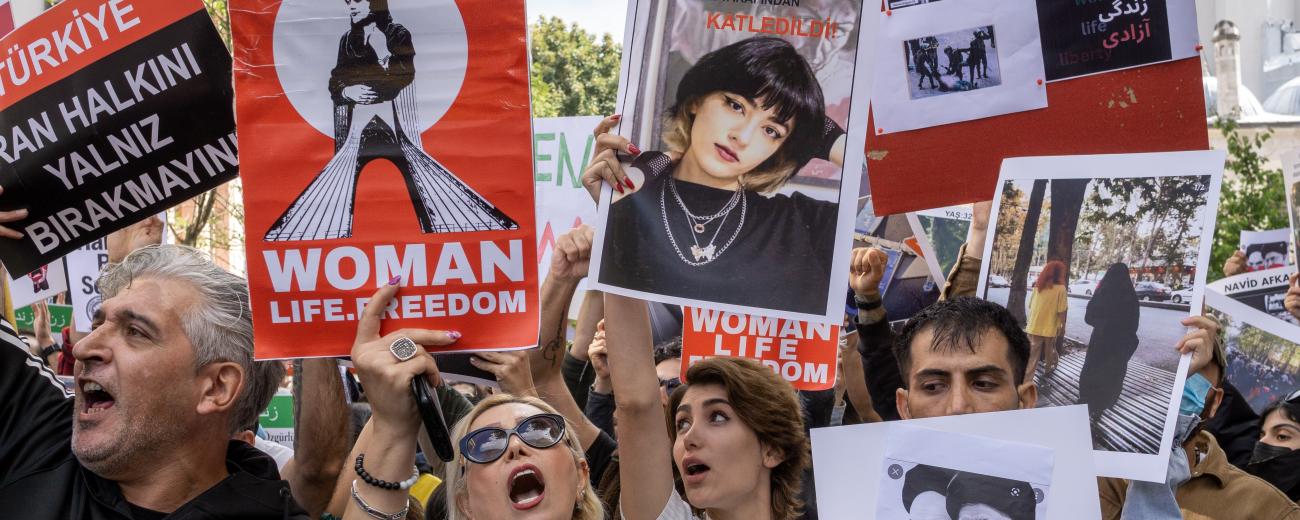Protests in Iran: Should we be optimistic?


For almost two months, Iran has seen massive protests throughout the country that have been spurred by the death of Mahsa Amini (or Jina Amini, as was her Kurdish name). The morality police of Iran had arrested her for not wearing a hijab in accordance with the government rules and regulations. There is evidence to believe that she died because of the injuries she sustained at the hands of the regime. SOAS Director, Professor Adam Habib, along with Professor Annabelle Sreberny, Negin Shiraghai and Azadeh Pourzand discussed the protests following Mahsa’s death and what may be in store in the future for Iran in the latest Director Lecture Series entitled ‘Women, life, freedom: achieving political change in Iran’.
Negin Shiraghai started off the discussion by reminding the audience that Mahsa was not the first woman to die because of the Iranian regime’s ruthlessness and that the current protests have a deep historical context. The 1979 Iranian Revolution sought to create an authentic Islamic identity as opposed to the western capitalist and liberal ideas that were slowly spreading throughout the world. Iran had had a history of protests against the regime, and the current protests are a testimony to people’s struggles in the past few decades and their fight for justice and equality.
Professor Sreberny added to that point by mentioning how it's compulsory for women to wear a hijab without having a say in the matter, but also the pressures they face in simply being a woman in a highly patriarchal society. The lawmakers of Iran are increasingly cracking down on the basic rights of women, with regards to divorce, abortion etc. Women have been treated as second class citizens, with no autonomy over their bodies, mind, or clothing to list just a few. While the death of Mahsa is a huge trigger point for the protests erupting throughout the country, it encompasses and is representative of the various issues that have been plaguing the country for a while now.
One of the questions Professor Habib raised, guided how the dialogue flowed. He asked how these protests are different from the protests the country has seen in the past decades. There was a mutual agreement between the three speakers on the role and involvement of social media. Social media has been responsible for giving a voice to the people and making sure that the voice reaches the ears of people at a global level.
It creates citizen journalism where you can get the word out on platforms such as Twitter, through pictures and videos shot on phones and live streams of events that the Iranian national news channels will not cover. Content freely being shared on social media instils collective rage and helps communities mobilise and coordinate. However, Azadeh Pourzand also warned the audience not to think of the protests in Iran only as a social media revolution. She reminded us all how it is still a real event happening to real people, and those involved are braving the regime in a bid to live with freedom.
These protests have also seen enormous amounts of resilience, bravery and commitment by the people of Iran. Iranians have dared to speak up and voice their opinions, with people from all over the world sitting up and paying attention. Many of those protesting on the streets are younger generations, with some even under the age of 18. Just this week, we also saw the Iranian national football team refuse to sing their national anthem at the Qatar World Cup.
People in Iran don't feel they are alone anymore. They feel seen. They feel heard. They don't feel isolated. There is hope for a change. The large number of young protestors still have the strength to dream of a better country with better politics. People have more access to resources and information than ever before, and they are taking full advantage of that. Some cracks seem to be appearing within the system, with the regime unable to completely quash the protest. Many of the teenagers and young adults are defying their parents, who are part of the system.
The Iranian diaspora too has been actively engaging with the issue and keeping themselves updated with what is going on - rather than choosing to distance themselves from the situation. The diaspora is standing in unity and solidarity to rally for their cause. They have been responsible for educating the people around them and bringing and sharing reliable resources.
It remains to be seen whether we should be optimistic about the protests in Iran, however the fact that the rest of the world is taking notice can only be a good thing. With world leaders putting pressure on the regime, people will be keeping a close eye on any developments in the next few months.
Watch the full recording of the lecture here.
About the author
Surabhi Sanghi is a SOAS Digital Ambassador, pursuing a master's degree in South Asian Studies and Intensive Language (which also means she gets to be in London for one whole extra year). She has a background in history and is interested in the religions of South Asia. She is a dog person and her only wish is to be able to pet all the dogs in London.